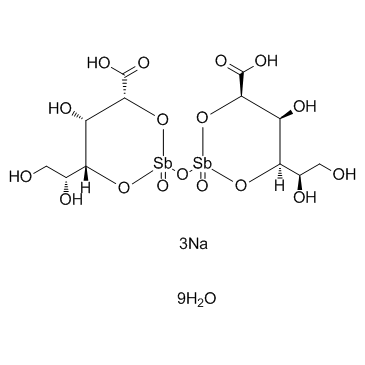16037-91-5
| Name | sodium stibogluconate |
|---|---|
| Synonyms |
1,3,7,9-Tetraoxa-2,8-distibacyclododecane-4,10-dicarboxylic acid, 6,12-bis[(1R)-1,2-dihydroxyethyl]-2,5,8,11-tetrahydroxy-, 2,8-dioxide, sodium salt, (4R,5R,6R,10R,11R,12R)-, hydrate (1:3:9)
stibanose stibinol ANTIMONY SODIUM GLUCONATE MFCD06795860 solustin SSG NASB stibatin stibanate myostibin pentostam Sodium (4R,5R,6R,10R,11R,12R)-6,12-bis[(1R)-1,2-dihydroxyethyl]-2,5,11-trihydroxy-8-oxido-1,3,7,9-tetraoxa-2,8-distibacyclododecane-4,10-dicarboxylate 2,8-dioxide hydrate (3:1:9) NASBV Stibogluconate (sodium) |
| Description | Stibogluconate sodium is a potent inhibitor of protein tyrosine phosphatase. Stibogluconate sodium inhibits 99% of SHP-1, SHP-2 and PTP1B activity at 10, 100, 100 μg/mL, respectively. |
|---|---|
| Related Catalog | |
| Target |
Phosphatase[1] |
| In Vitro | Stibogluconate sodium inhibits 99% of SHP-1 activity at 10 μg/mL, a therapeutic concentration of the drug for leishmaniasis. Similar degrees of inhibition of SHP-2 and PTP1B required 100 μg/mL Stibogluconate sodium. The inhibition of cellular PTPases by the Stibogluconate sodium is suggested by its rapid induction of tyrosine phosphorylation of cellular proteins in Baf3 cells and its augmentation of IL-3-induced Janus family kinase 2/Stat5 tyrosine phosphorylation and proliferation of Baf3 cells. The augmentation of the opposite effects of GM-CSF and IFN-α on TF-1 cell growth by Stibogluconate sodium indicate its broad activities in the signaling of various cytokines[1]. |
| In Vivo | Stibogluconate sodium induces 61% growth inhibition of Renca tumors in BALB/c mice coincident with an increase (2-fold) in tumor-infiltrating macrophages. A combination of Stibogluconate sodium and IL-2 is more effective in inhibiting tumor growth (91%) and inducing tumor-infiltrating (4-fold), whereas IL-2 alone has little effect[2]. |
| Cell Assay | Human myeloid cell line TF-1 is maintained in RPMI 1640 supplemented with 10% FCS and 40 ng/mL recombinant human GM-CSF. For cell proliferation assays, cells are washed in 10% FCS medium twice, resuspended in 10% FCS medium, incubated at 37°C for 16 h, and then cultured at 37°C in 10% FCS medium containing various amounts of cytokines, sodium stibogluconate, or potassium antimonyl tartrate for 3-6 days. The cell numbers in proliferation assays are determined by an MTT assay or by microscopic cell counting[1]. |
| Animal Admin | BALB/c and athymic nude BALB/c mice are inoculated (s.c.) at the flanks with Renca cells (106 cells/site). Four days after inoculation, the mice are subjected to no treatment (control) or treatment with IL-2 (105 IU/day for 5 days i.p.), Stibogluconate sodium (12 mg/day i.m. at hip regions), or the combination of the two agents for 2 wk. Tumor volume is measured during the study period and calculated using the formula for a prolate spheroid[2]. |
| References |
| Boiling Point | 673.6ºC at 760mmHg |
|---|---|
| Molecular Formula | C12H38Na3O26Sb2 |
| Molecular Weight | 910.90 |
| Flash Point | 375.2ºC |
| PSA | 399.06000 |
| Appearance | solid | pale yellow |
| Vapour Pressure | 4.95E-21mmHg at 25°C |
| Water Solubility | H2O: 1 mg/mL at ~75 °C |
CHEMICAL IDENTIFICATION
HEALTH HAZARD DATAACUTE TOXICITY DATA
|
| Hazard Codes | Xn,N |
|---|---|
| Risk Phrases | 20/22-51/53 |
| Safety Phrases | 61 |
| RIDADR | UN 3282 |
| WGK Germany | 3 |
| RTECS | CC7930000 |
| Packaging Group | III |
| Hazard Class | 6.1(b) |

